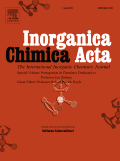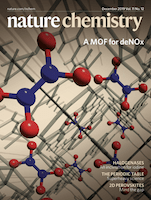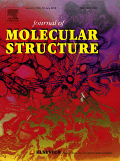
JOURNAL OF BIOLOGICAL INORGANIC CHEMISTRY
metrics 2024
Advancing Insights into Inorganic Elements in Biology.
Introduction
JOURNAL OF BIOLOGICAL INORGANIC CHEMISTRY, published by Springer, serves as a pivotal platform for the dissemination of research that intersects the fields of biochemistry and inorganic chemistry. With a commitment to advancing our understanding of the intricate roles that inorganic elements and compounds play in biological systems, this journal addresses a diverse array of topics from metal ion interactions in biological processes to the design of biomimetic systems. Hailing from Germany and reaching a global audience, it has maintained a distinguished status in its field, achieving a Q2 ranking in Inorganic Chemistry and a Q3 ranking in Biochemistry as of 2023, reflecting its impactful contributions to the scientific community. Although currently not open access, the journal provides vital insights that are essential for researchers, professionals, and students alike, promoting knowledge and collaboration in a rapidly evolving scientific landscape. With an expansive range of articles published since 1996, the JOURNAL OF BIOLOGICAL INORGANIC CHEMISTRY continues to be an indispensable resource for anyone working at the intersection of chemistry and biology, especially in understanding the biochemical implications of inorganic substances.
Metrics 2024
 0.54
0.54 2.70
2.70 3.10
3.10 112
112Metrics History
Rank 2024
Scopus
IF (Web Of Science)
JCI (Web Of Science)
Quartile History
Similar Journals

INORGANICA CHIMICA ACTA
Elevating Knowledge in Physical and Theoretical ChemistryINORGANICA CHIMICA ACTA is a distinguished journal published by Elsevier Science SA, focusing on the dynamic fields of inorganic chemistry, materials chemistry, and physical and theoretical chemistry. Established in 1967, the journal continues to contribute to the scientific community with a commitment to high-quality research and innovation, boasting a 2023 Scopus ranking that places it at the forefront of its category, including a notable rank of #25 out of 79 in Inorganic Chemistry. Researchers can access a wealth of knowledge through its assemblage of influential articles; though it does not offer open access, the journal remains a key resource in the Netherlands and beyond. With an impact factor reflective of its rigorous editorial standards and engagement, INORGANICA CHIMICA ACTA is essential for scholars and professionals seeking to deepen their understanding and advance their research in these interconnected scientific domains.

Inorganics is a vibrant, peer-reviewed Open Access journal dedicated to advancing the field of inorganic chemistry, published by MDPI since 2013. Based in Switzerland, this journal aims to provide a dynamic platform for researchers, professionals, and students to share groundbreaking findings, fostering collaboration and innovation within the global scientific community. With an impressive Q2 ranking in the category of Inorganic Chemistry as of 2023, Inorganics stands out as a significant conduit for high-quality research that spans a wide range of topics from coordination compounds to metal-organic frameworks. Its commitment to accessibility ensures that cutting-edge research can be accessed, utilized, and built upon by a diverse audience, thereby amplifying its impact. Join the conversation in Inorganics and contribute to the ever-evolving landscape of inorganic chemical research.

INDIAN JOURNAL OF CHEMISTRY
Connecting Researchers to the Latest in Organic, Inorganic, and Physical ChemistryINDIAN JOURNAL OF CHEMISTRY, published by the NATL INST SCIENCE COMMUNICATION & POLICY RESEARCH (NIScPR), stands as a vital platform for disseminating innovative research and advancements in the fields of organic, inorganic, and physical chemistry. With its inception in 1969, this journal has served the global community of chemists and researchers, contributing significantly to the advancement of chemical sciences in India and beyond. The journal maintains a strong commitment to open access, facilitating widespread dissemination of knowledge, allowing readers from diverse backgrounds to access cutting-edge research without barriers. Although coverage in Scopus has been temporarily discontinued, the journal continues to uphold rigorous scholarly standards, making it an authoritative source for academicians, professionals, and students alike. Readers can expect high-quality articles that reflect the latest developments and discoveries in chemistry, reinforcing the journal's reputation as an essential resource in the scientific community.

Nature Chemistry
Pioneering Research in Chemistry and Engineering.Nature Chemistry is a prestigious journal published by NATURE PORTFOLIO, focusing on groundbreaking research in the realms of chemistry and chemical engineering. Since its inception in 2009, this esteemed publication has garnered significant recognition, currently ranking in the Q1 category for both Chemical Engineering and Chemistry (miscellaneous) as of 2023. With an impactful presence, it ranks 4th out of 273 in General Chemical Engineering and 9th out of 408 in General Chemistry, placing it within the top 2% of journals in its field. Nature Chemistry aims to publish high-quality, peer-reviewed articles that advance our understanding of chemical science and its applications, catering to an audience of researchers, professionals, and students eager to explore innovative discoveries. While it offers various access options, dedicated readers appreciate its contribution to the scientific community from its base in Berlin, Germany.

PHOSPHORUS SULFUR AND SILICON AND THE RELATED ELEMENTS
Charting New Frontiers in Elemental ChemistryPHOSPHORUS SULFUR AND SILICON AND THE RELATED ELEMENTS, published by Taylor & Francis Ltd, is a distinguished journal dedicated to advancing knowledge in the fields of Biochemistry, Inorganic Chemistry, and Organic Chemistry. Established in 1989, the journal has carved a niche in the scientific community by offering a platform for the publication of innovative research that explores the chemistry and applications of phosphorus, sulfur, silicon, and related elements. With an ISSN of 1042-6507 and an E-ISSN of 1563-5325, this journal provides access to valuable insights, albeit without open access options. Despite being positioned in the fourth quartile of its categories (Q4), it remains an essential resource for researchers, professionals, and students seeking to expand their understanding of these pivotal elements and their interactions. With a publishing horizon extending to 2024, the journal invites contributions aimed at pushing the boundaries of chemistry and fostering interdisciplinary dialogue.

Journal of Molecular Structure
Empowering researchers with cutting-edge molecular research.Journal of Molecular Structure is a premier publication in the field of chemistry, offering a platform for innovative research that spans analytical, inorganic, organic chemistry, and spectroscopy. Published by Elsevier in the Netherlands, this journal is committed to advancing the understanding of molecular architecture and behavior through high-quality, peer-reviewed articles. With its impressive impact factor and a notable Scopus ranking placing it in the top quartiles among its peers, it serves as an essential resource for researchers, professionals, and students alike. The journal's open access options promote the dissemination of knowledge, ensuring that groundbreaking discoveries reach a broad audience. Established in 1967 and projected to continue through 2025, the Journal of Molecular Structure is vital for anyone engaged in the study of molecular interactions and structural analysis.

JOURNAL OF COORDINATION CHEMISTRY
Elevating Coordination Chemistry to New HeightsJOURNAL OF COORDINATION CHEMISTRY is a prestigious academic journal published by Taylor & Francis Ltd, focusing on the vital intersection of materials chemistry and physical and theoretical chemistry. Since its inception in 1971, the journal has provided a platform for disseminating high-quality research that explores the coordination chemistry of metals and its implications in various scientific domains. With an ISSN of 0095-8972 and an E-ISSN of 1029-0389, this journal serves a diverse community of researchers and professionals dedicated to advancing their understanding of coordination compounds and their applications. The journal's current rankings place it in the Q3 category for both Materials Chemistry and Physical and Theoretical Chemistry, with Scopus rankings highlighting its relevance and contribution to these fields. The absence of open access underscores the journal's commitment to maintaining rigorous academic standards while ensuring a broad reach through reputable publication practices. As it converges toward 2024, JOURNAL OF COORDINATION CHEMISTRY invites contributions that push the boundaries of knowledge and foster innovative research in multiple contextual applications.

DALTON TRANSACTIONS
Exploring the Depths of Inorganic ChemistryDALTON TRANSACTIONS, published by the esteemed Royal Society of Chemistry, is a premier journal in the field of Inorganic Chemistry, recognized for its significant contributions to advancing research and scholarship since its inception in 2002. With an impressive Impact Factor and ranked in the Q1 category, it holds a notable position at Rank #21 out of 79 within its Scopus category, highlighting its reputation for excellence and influence in the scientific community. This journal provides a platform for disseminating high-quality research, reviews, and communications related to all aspects of inorganic chemistry, fostering collaboration and innovation among researchers, professionals, and students alike. Although it does not offer open access, its robust selection process and commitment to scholarly integrity ensure that published works are of the highest standard. For those passionate about inorganic chemistry, DALTON TRANSACTIONS serves as an essential resource, fostering a deeper understanding of the field and its applications.

TRANSITION METAL CHEMISTRY
Navigating the Evolving Landscape of Transition MetalsTransition Metal Chemistry is a distinguished journal published by Springer, focusing on the latest advancements in the field of inorganic chemistry, materials science, and metals and alloys. With an impressive publication history dating back to 1975, this journal serves as an essential platform for researchers and professionals seeking to explore the complexities and innovations in transition metal chemistry. Transition Metal Chemistry holds a Q4 ranking in Inorganic Chemistry and positions itself in Q3 within both Materials Chemistry and Metals and Alloys categories, highlighting its evolving influence in these domains. With a Scopus ranking of #41 in Inorganic Chemistry and #56 in Materials Science, it provides readers with valuable insights into research trends and discoveries. Although it does not offer open access, its rigorous peer-review process ensures that only the most impactful and validated studies are published. By bridging theoretical concepts and practical applications, Transition Metal Chemistry plays a pivotal role in advancing scientific knowledge, attracting a diverse audience of researchers, students, and industry professionals committed to unraveling the complexities of transition metals.

CHEMISTRY-A EUROPEAN JOURNAL
Pioneering Insights in Chemistry and CatalysisCHEMISTRY-A EUROPEAN JOURNAL is a premier academic journal published by WILEY-V C H VERLAG GMBH, specializing in the diverse fields of chemistry and catalysis, with a distinguished focus on organic chemistry. Since its inception in 1995, the journal has established itself as an authoritative resource for researchers and professionals, currently classified in Q1 in Chemistry (miscellaneous) and Organic Chemistry, reflecting its high-quality contributions to the scientific community. With an impressive impact factor and robust Scopus rankings—#33 in Organic Chemistry and #26 in Catalysis—this journal serves as a vital platform for disseminating innovative research findings and critical advancements in chemical sciences. Although not an open-access journal, it provides valuable access options for institutions, ensuring wide reach and engagement within the scientific community. As it converges into 2024, CHEMISTRY-A EUROPEAN JOURNAL remains a key resource for anyone dedicated to advancing the frontiers of chemistry research.